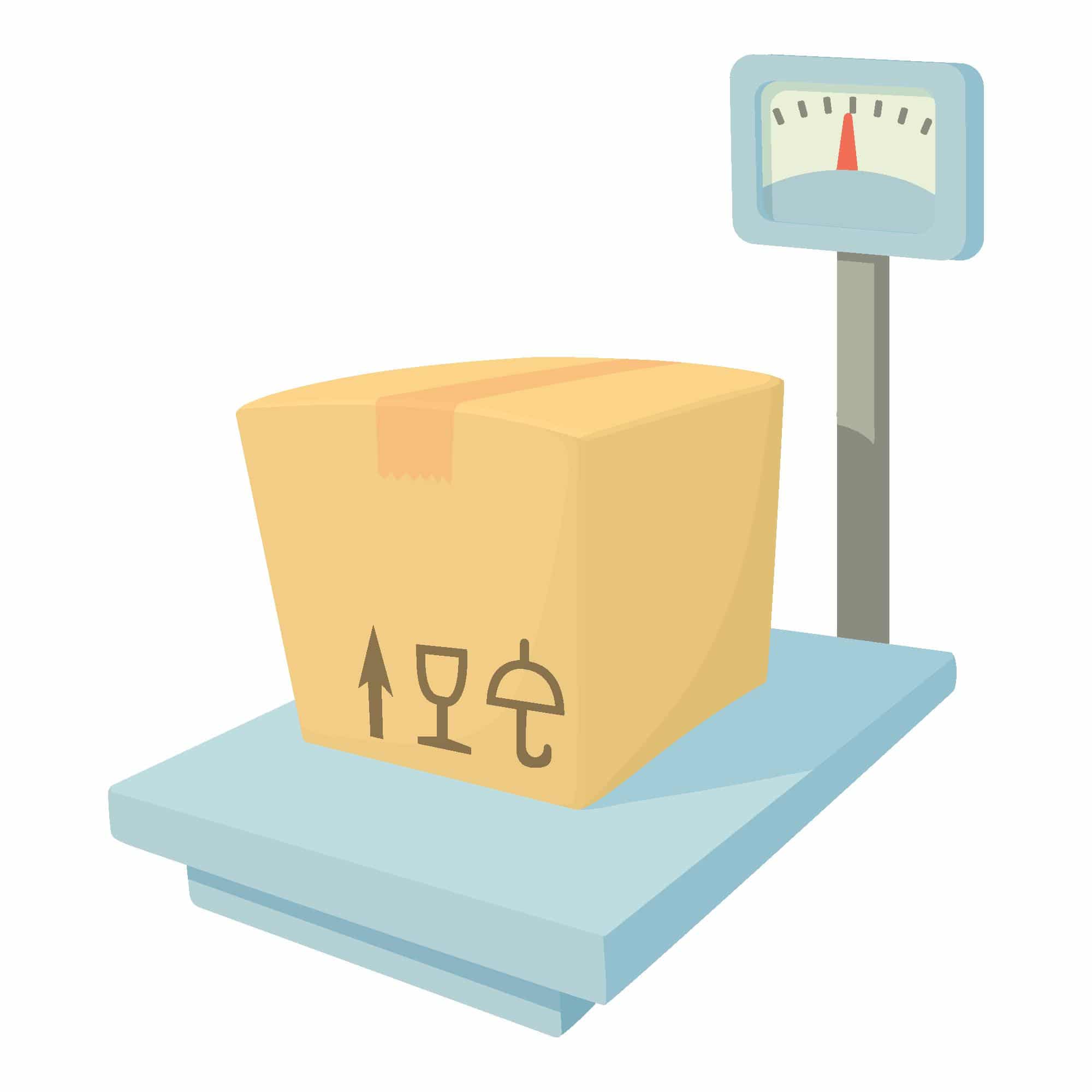
Volume Weight: What Is It, and How Does It Affect Shipping Costs?
How many of you have been on your holibobs with a suitcase that needs the weight of a human to close it? Everyone, right? But did you know couriers such as DHL, FedEx and UPS have this space-related problem every day when transporting goods?
You see, there’s only so much space in a ship, plane, train or truck. And couriers need a way to maximise their capacity and ultimately, their revenue. A big part of this is making the most of lightweight items that occupy a lot of space.
Say hello to volumetric weight.
What is volumetric weight?

Volume weight is what shipping companies use to calculate the price of a parcel. It takes into account the dimensions of the parcel and its weight, as opposed to weight alone.
As well as being the most profitable way for shopping companies to charge for the space a parcel takes up, it also ensures there’s as little empty space as possible in the delivery vehicle.
So, when and why is it used?
Most couriers use volume weight to calculate shipping costs, including FedEx, DHL and UPS. They do this because it provides the most accurate price, taking into account the size and weight of the parcel. But how is it calculated? Well let me explain.
Let’s say you have two parcels: parcel one is a large box that weighs 5 kg and parcel two is a small box that weighs 9 kg. Because of its size, parcel one will take up more space. So, to maximise capacity in the delivery vehicle, the courier will charge more for the larger parcel if the volume weight is higher— despite its physical weight being less.
If a courier is transporting a lot of large and light parcels, there will be fewer parcels in the vehicle than if they were carrying small and heavy items. By using volume weight, couriers can account for the space a parcel takes up.
And why do I need to know about it?
Volume weight affects anyone that regularly ships goods. So, knowing the calculations behind shipping fees and staying up to date with any changes that might affect the cost of shipping is important.
The price of volume weight could leave you unable to ship goods internationally, whether by air, sea or land. If this happens, it could leave you unable to ship your goods, as the cost of shipping may exceed the amount you paid for the items. This is why it’s important to understand which items make sense financially if you’re receiving them internationally.
If you’re sending goods for business purposes, understanding shipping costs and staying up to date with fees could be the difference between fulfilling customers’ orders on time and leaving them in limbo. It’s also wise to plan, too. This reduces the risk of any surprises that could leave you low on stock.
Difference between volume weight and physical weight
One second while I fetch my physics cap. But no — don’t worry, we’re here to keep things simple. And anyhow, the difference between volume and physical weight is super straightforward.
- Volume weight: this is a measure of how much space a parcel takes up using its dimensions. Think length, width and height.
- Physical weight: is a measure of how heavy a parcel is according to the scale. Think grams and kilograms.
Makes sense, right?
Volume and physical weight are two completely different things, and are both a factor when shipping goods. As a result, a large box of cuddly toys might be considered heavier — and therefore more expensive to ship — than a small box of iPads.
How is volume weight calculated?

It’s pretty easy to calculate the volume weight of a parcel. You’ll need a tape measure (or a ruler) and a DIM divisor (usually 5000) from your freight company.
From the longest point on each side, measure your parcel’s length, width and height. This is what’s called the cubic size. Now divide the cubic size by the DIM divisor to get the volumetric weight.
Here’s a quick step-by-step guide to help you:
- From the longest point, measure the length, width and height. For odd-shaped parcels, add centimetres to account for any bits that aren’t even.
- Round each number to the nearest ten. So if the length is 16.7 centimetres, round it up to 17.
- Multiply the dimensions to get the cubic size.
- Divide the cubic size by the DIM divisor (this is set by the freight company).
And he’s a formula calculation:
Let’s say the parcel dimensions are 60, 40, 50 cm.
That would be:
60 x 40 x 50 / 5.000
= 24
The volume weight of the package is 24kg.
How you can benefit from using MyUKmailbox
While it sounds like a pretty easy thing to do, there’s an art to packing and shipping parcels correctly. If you do it regularly, you’ll need to get it right if you want to keep costs down and ship sustainably. That’s where MyUKmailbox comes in.
There are a lot of benefits to using a company like ours. The main one is that we’ll save you money. As well as limiting void space to a minimum, we’re experts at turning multiple bulky parcels into one compact parcel. The fewer items you send, the less you’ll spend on shipping.
We also understand the principles of logistical shipping and know how to make educated decisions for repacking and consolidating goods — taking the guesswork out of shipping internationally.
Our expertise comes in handy day-to-day, too. We’re on hand to give you advice on everything related to buying goods from overseas. Whether it’s about fees, weight or delivery methods — we’re here to help, whenever you need.
Sign up today!
Recent Posts
Categories
- Blog (60)
- Deals (91)
- MyUKmailbox (14)
- News (12)
- Testimonials (3)
- Uncategorized (8)
- Video (1)
Archives
- November 2023 (2)
- October 2023 (1)
- August 2023 (1)
- July 2023 (1)
- June 2023 (1)
- May 2023 (1)
- April 2023 (1)
- March 2023 (1)
- February 2023 (1)
- January 2023 (2)
- December 2022 (1)
- November 2022 (1)
- October 2022 (1)
- August 2022 (1)
- July 2022 (2)
- June 2022 (3)
- May 2022 (9)
- April 2022 (2)
- March 2022 (3)
- February 2022 (2)
- November 2021 (1)
- October 2021 (2)
- September 2021 (2)
- August 2021 (3)
- July 2021 (3)
- June 2021 (1)
- May 2021 (1)
- April 2021 (3)
- March 2021 (3)
- February 2021 (1)
- January 2021 (3)
- December 2020 (3)
- November 2020 (1)
- October 2020 (2)
- September 2020 (2)
- August 2020 (1)
- July 2020 (2)
- June 2020 (1)
- May 2020 (1)
- March 2020 (2)
- January 2020 (2)
- December 2019 (2)
- November 2019 (1)
- October 2019 (1)
- September 2019 (2)
- August 2019 (2)
- July 2019 (2)
- June 2019 (2)
- April 2019 (1)
- March 2019 (3)
- February 2019 (2)
- January 2019 (2)
- December 2018 (1)
- November 2018 (1)
- October 2018 (3)
- September 2018 (3)
- August 2018 (1)
- July 2018 (3)
- June 2018 (2)
- May 2018 (2)
- April 2018 (2)
- March 2018 (2)
- January 2018 (1)
- December 2017 (1)
- November 2017 (1)
- October 2017 (1)
- September 2017 (2)
- August 2017 (1)
- July 2017 (1)
- June 2017 (2)
- May 2017 (3)
- April 2017 (2)
- March 2017 (3)
- February 2017 (2)
- January 2017 (3)
- December 2016 (3)
- November 2016 (3)
- October 2016 (4)
- September 2016 (3)
- August 2016 (3)
- July 2016 (2)
- December 2015 (29)


